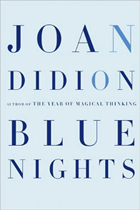By Joan Didion
Knopf, $25.00, 188 pages
In Blue Nights, acclaimed author Joan Didion writes a powerful contemplation of what it is to lose a daughter. True to her previous books, Didion writes with candor, lyrical precision, and a masterful understanding of the complexities of human emotion. She opens her book reminiscing about the New York wedding of her daughter Quintana Roo. And she wonders, as so many of us do, how knowledge of the future might have affected the way she was then: “Could you have seen, had you been walking on Amsterdam Avenue and caught sight of the bridal party that day, how utterly unprepared the mother of the bride was to accept what would happen before the year 2003 had even ended?”
“Seven years ago today we took the leis from the florist’s boxes and shook the water in which they were packed onto the grass outside the Cathedral of St. John the Divine on Amsterdam Avenue. The white peacock spread his fan. The organ sounded. She wove white stephanotis into the thick braid that hung down her back. She dropped a tulle veil over her head and the stephanotis loosened and fell. The plumeria blossom tattooed just below her shoulder showed through the tulle. ‘Let’s do it,’ she whispered.”
Didion spends much of this brief book contemplating the what-ifs as she considers her own aging process, her daughter’s adoption and childhood and the fears they both shared. She wraps her book in the poetic metaphor of “blue nights” a period in some latitudes when the summer twilight seems interminable: glittering and yet chilling, peaceful and yet foreboding. Didion explains that as she wrote Blue Nights her thoughts turned increasingly to illness and the inevitability of death: “Blue nights are the opposite of the dying of the brightness, but they are also its warning.”
Jennie A. Camp
[amazon asin=0307267679&text=Buy On Amazon&template=carousel]

